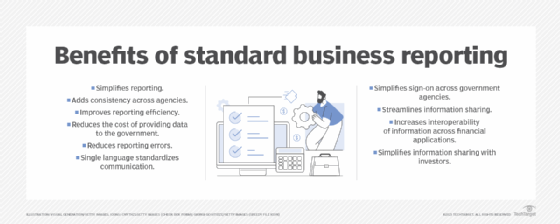standard business reporting (SBR)
What is standard business reporting (SBR)?
Standard business reporting (SBR) is a group of frameworks adopted by governments to promote standardization in reporting business data. The core idea is to make filing reports related to tax and customs administration, business performance and compliance easier. The concept is gaining ground in the Netherlands, Australia and New Zealand.
However, most countries allow enterprises and financial experts to develop their own frameworks through standardization efforts developed as part of the Extensible Business Reporting Language (XBRL). In both cases, the idea is that enterprises can post their numbers once and then reuse them across various regulatory and investor reporting processes.
SBR proponents believe the framework can ease the burden of business-to-government reporting and improve the usefulness of information for all parties. In particular, SBR can help relieve the regulatory burden of formatting related information for different government agencies. For example, many governments request related information using terms that might be known under a different title.
As a result, finance and accounting teams must analyze, assemble and reformat similar information for different government agencies. SBR helps standardize terminology across government agencies to ease the burden on businesses.
How does SBR work?
SBR provides taxonomies to standardize related data across reporting requirements for government agencies. The fundamental issue is that every enterprise generates lots of numbers representing different aspects of their business. But these numbers can mean slightly different things across various contexts.
Take a simple example like a company name. One analysis by the Australian treasury found nine different names used to describe a company's Australian Business Number across different forms and government agencies. In Australia's case, an SBR task force identified 100 reforms to existing regulations and suggested another 50 areas to be investigated.
At the heart of SBR is the notion that finding a way to agree on what data means can go a long way to streamlining sometimes confusing reporting requirements. It can help align reporting requirements with business analysis processes to identify opportunities for improvement. For example, teams could explore how different business process reengineering efforts affect the bottom line and sustainability goals around net zero, circularity, diversity and inclusion.
Why is SBR important?
Many governments are starting to impose fines and harsher penalties on executives who deliberately or even inadvertently sign off on inaccurate numbers. As a result, executives are under increasing pressure to ensure all their numbers and descriptions are filed correctly.
The problem is that government agencies have evolved with different goals, terminology and reporting requirements. SBR helps create a framework and process for government agencies to come to an agreement on what the numbers and descriptions mean.
The Australian Treasury estimated that compliance-related activities could take up to 25% of some senior management's time. SBR promises to reduce this time burden so managers can focus on adding value to the business and larger community, for example, when working across Australian territories.
A few countries, like the Netherlands, Australia and New Zealand, have worked to standardize the different ways of describing data across agencies. In the ideal case, more government agencies would work together to develop common standards within each country and across different countries.
How is SBR implemented?
SBR is implemented on a nation-by-nation basis. Government regulators work with commercial accounting software developers, accountants, payroll tax professionals and bookkeepers to develop a taxonomy to describe the data enterprises share with government regulators, tax and customs authorities, and other parties.
Accounting and financial application developers then incorporate these taxonomies into their software to make it easier to coordinate the data gathered. For example, procurement and sales data could automatically be captured from business processes and translated into the appropriate format. Businesses can then automate the process of filing all of the appropriate paperwork using existing financial applications.
Benefits of SBR
Some of the benefits of SBR include the following:
- Uses a simplified reporting process.
- Consistency across agencies reduces information processing.
- Improves reporting process efficiency.
- Frees business leader time for higher-level analysis.
- Increased automation reduces reporting errors.
- Mitigates risks of inaccurately reporting information.
- A single language standardizes communication across government agencies.
- Reduces the cost of assembling, analyzing and providing data to the government.
- Simplifies sign-on across government agencies.
- Streamlines information sharing across enterprise departments.
- Increases interoperability of information across financial applications.
- Simplifies information sharing with investors.

History of SBR
The Netherlands started work in SBR in 2004 as part of the Netherlands Taxonomy Project. Various government agencies collaborated with industry experts to create an XBRL taxonomy to exchange reports. By 2017, most companies in the Netherlands were required to file their annual reports using SBR.
Australia launched its SBR program -- known as the Australian Business Register -- in 2010. New Zealand followed suit in 2013. Several other countries -- including Canada, Denmark, Finland, Poland, Sweden and Turkey -- have since asked the Netherlands for advice on setting up their own programs. The EU has also explored the concept. However, none of these efforts have taken off.
SBR vs. XBRL
Governments, financial professionals and technology vendors seem to be embracing XBRL. But government agencies tend to move slower than open standards bodies. In the short term, it might be more practical to use industry standards like XBRL to help automatically translate the meaning of data across the taxonomies used by various agencies.
John Carey, managing director of the Digital and Technology Solutions group at AArete, a global management and technology consulting firm, suggested that generating SBR reports might not always be straightforward. Governments outside the Netherlands, Australia and New Zealand have not mandated a specific reporting format. As a result, the industry has witnessed a shift toward embracing XBRL frameworks to achieve similar reporting objectives.
For one, XBRL represents a broader and more open standard. "XBRL, as an extension of XML [extensible markup language], offers a relatively simpler adoption process for organizations, as many already possess the necessary internal competencies to work with XML-based data formats," Carey said.
In contrast, SBR is more focused and tailored to specific government requirements, potentially making it less versatile in accommodating diverse reporting needs compared to the extensibility of XBRL.
Going forward, Carey expects the use of both SBR and XBRL to evolve. XBRL, in particular, enjoys a wide-reaching following and is poised for further adoption across various sectors and industries. Its open nature and compatibility with existing data structures make it an attractive choice for organizations seeking to streamline their reporting processes.
"Additionally, the adoption of reporting frameworks like SBR and XBRL will likely see continued growth as part of broader efforts to enhance accountability and data consistency in reporting practices," Carey said.








